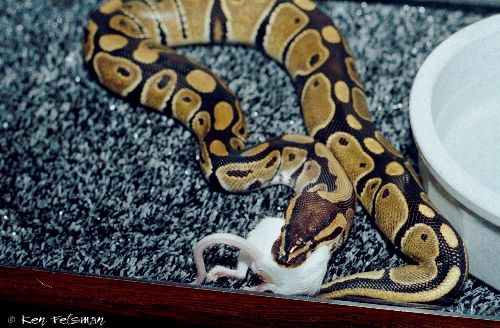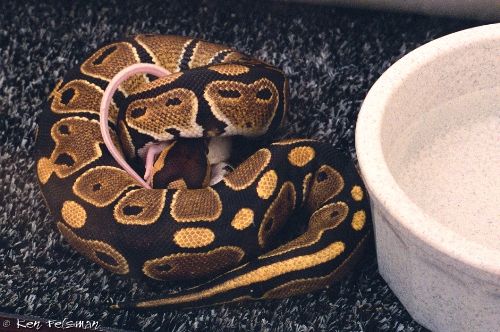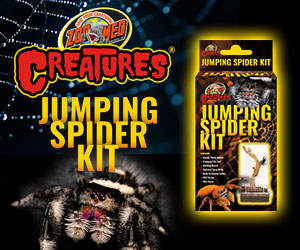
Troubleshooting Guide to BALL PYTHONS |  |
Feeding Strategies
 You may, or may not, have heard that Ball Pythons can be finicky eaters. This is somewhat true. Wild caught adults are generally by far the more frustrating feeders. Captive hatched and captive bred snakes seem to adjust better to captivity and are better about eating on a regular basis. The process of feeding occurs in a few steps. First the snake identifies prey by the scent, color, size, movement, and temperature. If the Ball Python feels that it's in a safe location and won't be molested during the eating process, it will bite and coil around the intended prey item. The coil is intended to kill the prey by suffocation. After the prey stops moving, the snake then usually finds the head and begins the process of swallowing. After the food is in it's stomach, the snake will want to find a small, dark, and warm location to lay around for four or five days and digest the food. In the wild, this warm and dark location is usually a rodent burrow, after the snake has eaten the inhabitants.
You may, or may not, have heard that Ball Pythons can be finicky eaters. This is somewhat true. Wild caught adults are generally by far the more frustrating feeders. Captive hatched and captive bred snakes seem to adjust better to captivity and are better about eating on a regular basis. The process of feeding occurs in a few steps. First the snake identifies prey by the scent, color, size, movement, and temperature. If the Ball Python feels that it's in a safe location and won't be molested during the eating process, it will bite and coil around the intended prey item. The coil is intended to kill the prey by suffocation. After the prey stops moving, the snake then usually finds the head and begins the process of swallowing. After the food is in it's stomach, the snake will want to find a small, dark, and warm location to lay around for four or five days and digest the food. In the wild, this warm and dark location is usually a rodent burrow, after the snake has eaten the inhabitants.
So how often should you offer food to your snake? Well that depends on a few factors, notably the age of the snake. Younger snakes (16-30 inches) that are still growing fast will need more food. Older snakes (30-48 inches) won't need to feed as often. I feed my young snakes once every 7-10 days. They are capable of eating small to average size mice as hatchlings. Adults can pretty easily eat a rat that measures five or six inches from nose to butt. I feed my adult males about every three weeks, and the adult (breeding) females eat about once every two weeks. Snakes eat whole animals and do not need vitamin supplements, although you may want to add a little calcium to a gravid (pregnant) female's diet to help in egg production. This feeding schedule assumes that the adults will be off feed for a few months during the winter/breeding season. You may find other information on Ball Pythons that suggest feeding more often, but I believe that most people over feed their snakes. Snakes in the wild never have the opportunity to become obese due to less food availability, and more activity hunting for it.
Should you be offering live or dead food? It generally depends on the individual snake, but I offer prekilled food items. Dead food can't fight back, and I can kill the rodent quicker (less pain for the animal) than a snake does. If the snake has gone awhile without food, is looking thin, and I've exhausted most other options, live food is something worth a try. The downside to offering live food is that the rodent will fight back and can harm your snake. Do NOT leave a live rodent in a cage with a snake unattended! If the rodent attacks your snake, it will scar it, and possibly deter the snake from eating. This photo shows some scarring which is typical of prey items bites/attacks. I have enough of a need for rodents, that I get them frozen by mail order. After a few hours of thawing under a heat lamp, most of my snakes readily eat. Most pet stores will prekill a rodent for you if you ask. If it's left up to you, there are a few simple and painless ways to get the job done. The easiest would be to place the rodent into a small paper bag and hit it against a hard stationary object. The rodent impacts with enough force to instantly kill it. The other option, is to hold the rodent by the tail. Using a ruler or similar object pin it to a table top at the base of the skull. With a quick pull of the tail up from the table, you break it's back and separate the spinal column, thus killing the rodent. In my opinion, either of these two methods are the best way to accomplish this uncomfortable task.
What type of prey item should you offer to your Ball Python? Ideally your snake will eat either lab mice or rats which are cheap and easy to get. I would strongly caution against feeding your snake wild mice or other animals. There is no way of telling what diseases, parasites, or poisons that a wild mouse is carrying. Gerbils and gerboas are a Ball Python's natural food item. If your snake doesn't happen to like rats or mice, a regular pet store gerbil is pretty tempting, albeit a little more expensive.
What can I do to get this snake to eat?! This is a question that most Ball Python owners have asked themselves at one time or another. The first thing you should do is RELAX. A six or eight month fasting period is not unheard of, nor in most cases will it harm your snake. I would suggest getting a postal scale and monitor any weight loss. If your snake doesn't loose much more than about 15-20% of it's original weight you shouldn't worry. Stress is usually the reason that Ball Pythons don't eat. Your Ball Python can be feeling stress: from not being comfortable in it's (new) home, from parasites (either internal or external), from you handling the snake too much, or from infections (respiratory, mouth rot, blister disease, etc). Assuming that the snake is otherwise healthy, free of parasites, and just not eating, try some of the following:
- Double check that your temperature and humidity cycles are correct and your snake has a few places to hide in the cage (see husbandry).
- What season is it outdoors? It's pretty common for adult males (and sometimes females) to go off feed during the winter months, as that is also the breeding season.
- If your snake is shying away from the food item, chances are it's stressed about something.
- Are you handling/disturbing the snake? If so how often? Try leaving the snake alone for a week or so and then offer food.
- Is there another snake in the tank? Some of my Ball Pythons do not eat unless they are the only snake in the cage.
- Is the cage in a room that gets a lot of foot traffic and noise? Try moving it to a more quite room.
- Is it within a few days of, or during a shed cycle? Most snakes won't eat during this period.
- Are you offering live? Try offering dead, or if you are offering dead, try offering live.
- How large of a meal are you offering? Even though they might be able to swallow a large meal, some snakes prefer smaller ones.
- Are you offering different types of rodents?..Mice? Rats? Gerbils?
- What color of rodents are you offering? Some snakes don't recognize white lab mice and rats as food items. Try and get some with some color on them.
- Are you offering male or female rodents? Some snakes show a preference one way or the other.
- What is the temperature of the dead rodent? Sometimes a fresh kill is the right temperature, and a thawed rodent isn't.
- When you offer food, how are you doing it? Are you disturbing the snake first? a lot of times, if you use the hemostats× and dangle a rodent in front of the snake or, just in front of the hole in the hide box, the Ball Python will take it.
- What time of day are you offering food? Remember that Ball Pythons are nocturnal and may not want to eat if it's light out.
- Are the lights on in the room when you offer food? Some snake like it dark when they eat.
- How far away from the snake is the rodent? Somewhere around 2-6 inches from the snakes face is about right.
- Try putting the Ball Python in a brown (opaque) paper bag over night with a DEAD rodent. Make sure you put the bag back into the tank! Sometimes they get out of the bag.
- Talk to the pet store and see if they will provide you with some soiled gerbil bedding. Place that in the paper bag with the rodent.
- Try scenting a dead rat or mouse by rubbing it against a dead gerbil.
- Try thawing a rodent, refreezing it, and thawing it again. The freezing process breaks down the cell walls and makes the rodent smell more pungent.
- It isn't very pleasant, but try splitting or cutting the dead rodent's skull so that some brain matter and blood come out.
Occasionally the snake decides to take a rodent, but it's not the preferred size of meal. A small mouse is but a snack for an adult Ball Python. Sometimes if you offer a few items, the snake will eat more than one rodent at a sitting. You can also strongly encourage a Ball Python to take a second (or third) rodent during the last stages of swallowing the previous one. As the last of the legs go down, using the hemostats, you can introduce the head of another rodent into the snake's open mouth. Most of the time, the feeding response is strong enough that the snake will just keep swallowing. I use this technique with my adult pythons which usually take gerbils or mice. You can get them to swallow a rat after the gerbil/mouse and end up with a good sized meal for the snake.
Notice in the preceding section that I did NOT suggest you try and force feed your snake? I don't think that force feeding is something which should be done. It's stressful on you and the snake. Force feeding is something which was done by a lot of zoos many years ago before the keepers knew exactly what the care requirements were for snakes. They would force food and/or a liquid diet down a snake's gullet by use of a rubber hose or broom handle in some cases. This does not solve any problems and creates a lot more. The slight exception that I have to that rule is "Assist Feeding" of hatchlings. I do NOT suggest trying this on adults! Sometimes hatchlings don't eat right way. After six weeks of trying or so, I have done what I call assist feeding. Grab a small dead mouse (aka hopper or fuzzy) with the hemostats just behind the head. Then grab the hatchling Ball Python just behind the head with your thumb and forefinger. GENTLY use the nose/face of the rodent to open the snake's mouth. Usually once the mouse's head is in the snake's mouth, a feeding response will kick in and the snake will start to swallow the mouse once you set the snake down. I do NOT force the mouse down the snakes throat! This can cause injury to the snake, and is not advisable. It's been my experience that given time, the right conditions, and patience, Ball Pythons will eventually eat.
|
Sponsored Link
Recent Ball Pythons Forum Posts
• Is This Enough Airflow?, posted by BelatedBoa
• Can’t find extremely rare morph: normal, posted by breitenup
• Sick Python, posted by pandalumps
• Introducing New Morph, the "Nguyen", posted by KNreptile
• Picture Request, posted by zippy00_99
• Mystic VS Mojave, posted by alchemyreptiles
• Ball Python Eggs ????, posted by mingdurga
• Wrinkly baby ball, posted by jmsandlin
• 6 y.o male hypo, het albino - San Diego, posted by zraverherp
• Opinions please on these snakes..., posted by ArmorofGod
• Female Lemon Blast Spider Ball Python, posted by Northwest
• Super banana spider, posted by jerryruiz510
• Stressed? (Change in behavior), posted by MessickMe
• ball python acting strangely, posted by jmsandlin
• White Diamond, posted by RichardHurtz
• Help with Bamboo Vanilla Ghost clutch, posted by Chad_Ramsey
• New Owner . . . soon, posted by Leah844
• Ball Python, posted by alexisstar
• How to maintain humidity?, posted by HiddenMe
• Eating problems, posted by Pythons1233
Recent Ball Python Classifieds:
- Pastel Clown Het Lavende...
- Cherry Bomb
- Lavender Albino Het Clow...
- Killer Clown Het Desert ...
- SALE Albino Het Pieds
- Albino Clown
- Pastel Puma
- Pinstripe Het Ghost Het ...
- Lesser Calico Shatter He...
- For Sale Pastel Lesser H...
- Pastel Het Caramel Albin...
- Ghost Het Pied
- Albino Het Pieds
- Proven Adult Female Moja...
- Adult Female Pastel Clow...
New & Updated Business Listings
Looking for a reptile or amphibian related business? A reptile store, breeder, importer,
maunfacturer or supplier? Our business directory lists some of the most popluar herp businesses in the world.
| Locate a reptile or amphibian business by name:
|
|
|





 You may, or may not, have heard that Ball Pythons can be finicky eaters. This is somewhat true. Wild caught adults are generally by far the more frustrating feeders. Captive hatched and captive bred snakes seem to adjust better to captivity and are better about eating on a regular basis. The process of feeding occurs in a few steps. First the snake identifies prey by the scent, color, size, movement, and temperature. If the Ball Python feels that it's in a safe location and won't be molested during the eating process, it will bite and coil around the intended prey item. The coil is intended to kill the prey by suffocation. After the prey stops moving, the snake then usually finds the head and begins the process of swallowing. After the food is in it's stomach, the snake will want to find a small, dark, and warm location to lay around for four or five days and digest the food. In the wild, this warm and dark location is usually a rodent burrow, after the snake has eaten the inhabitants.
You may, or may not, have heard that Ball Pythons can be finicky eaters. This is somewhat true. Wild caught adults are generally by far the more frustrating feeders. Captive hatched and captive bred snakes seem to adjust better to captivity and are better about eating on a regular basis. The process of feeding occurs in a few steps. First the snake identifies prey by the scent, color, size, movement, and temperature. If the Ball Python feels that it's in a safe location and won't be molested during the eating process, it will bite and coil around the intended prey item. The coil is intended to kill the prey by suffocation. After the prey stops moving, the snake then usually finds the head and begins the process of swallowing. After the food is in it's stomach, the snake will want to find a small, dark, and warm location to lay around for four or five days and digest the food. In the wild, this warm and dark location is usually a rodent burrow, after the snake has eaten the inhabitants.





